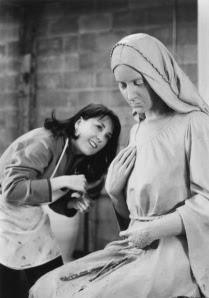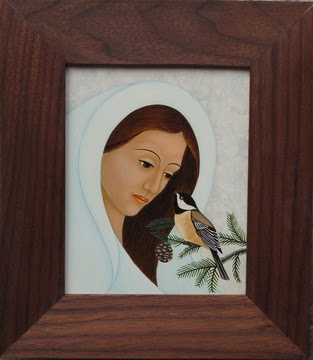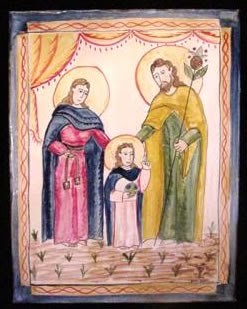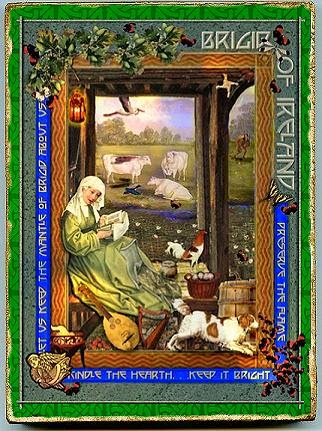![]() |
| St. Germaine |
For years I have prayed to Sts. Genevieve, Germaine and Cuthbert for safe and healthy lambs. But there are more out there waiting to be called upon for their gifts. There are patrons of the sheep themselves, of the lambs, of the ram, of the shepherd and shepherdess, and even of the vet, who may be called in for his/her earthly talents.
ST. GERMAINE COUSINwas born in the remote village of Pibrac in 1579. Germaine was a frail and sickly child. Her right arm was deformed and partially paralyzed. She was prey to every disease of the times due to the unsanitary conditions under which she lived.
Germaine was a shepherdesswho lived with the animals she tended. She had a mattress of hay and twigs in the corner of the barn. She was never sent to school, merely instructed briefly in order to make her First Holy Communion. The girl was shunned by children of her own age, and ignored by adults. Her only refuge was the Church. There she heard Mass every morning.
When St. Germaine died in 1601, the animals were the only ones there to comfort her. The night she passed from this life to the next life, two monks traveling from Toulouse had a remarkable vision. At midnight, they were awakened by heavenly music overhead, accompanied by a pathway of light, inhabited by angels. A tip of the luminous pathway rested over a barn in the distance. It seemed Germaine was being escorted into heaven.
Pope Gregory XVI declared Germaine "Venerable" on May 23, 1845, stating Germaine is the saint we need." Pope Pius IX beatified Germaine on May 7, 1854. He then canonized St. Germaine on June 29, 1867. He said, "Go to Germaine. She is a new star shedding a marvelous glow over the Universal Church."
ST. SOLANGE of BOURGES (d.. 880) was a Frankish shepherdess, born to a poor but devout family in the town of Villemont, near Bourges. She consecrated her virginity at the age of seven and according to some, her mere presence cured the sick and exorcised devils. The son of the count of Poitiers was highly taken with the beauty and popularity of Solange and approached her when she was working on tending to her sheep, but she rejected his suit. He argued with her to no avail, and so he decided to abduct her.
![]()
At night, he came and took Solange by force, but she struggled so violently that she fell from his horse while he was crossing a stream. Her abductor grew enraged and beheaded her with his sword. Solange's severed head invoked three times the Holy Name of Jesus, according to the fully developed legend. Solange picked up her head in her own hands and walked with it as far as the church of Saint-Martin in the village of Saint-Martin-du-Crot (which now bears the name of Sainte-Solange, the only commune in France to bear this name), only dropping truly dead there.
ST. GENEVIEVE was born about the year 422, at Nanterre near Paris. When she was little she didn’t attend school as she had to help her father with the sheep that her family owned. When she was watching the sheep, Genevieve often prayed. Sometimes she would just sit and think about how she could carry on the Lord’s mission.
![]() |
| St. Genevieve |
She was seven years old when St. Germain of Auxerre came to her native village on his way to great Britain to combat the heresy of Pelagius. The child stood in the midst of a crowd gathered around the man of God, who singled her out and foretold her future sanctity. At her desire the holy Bishop led her to a church, accompanied by all the faithful, and consecrated her to God as a virgin.
![]() |
| St. Genevieve-Louveciennes, France |
When Attila was reported to be marching on Paris, the inhabitants of the city prepared to evacuate, but St. Genevieve persuaded them to avert the scourge by fasting and prayer, assuring them of the protection of Heaven. The event verified the prediction, for the barbarian suddenly changed the course of his march.
The life of St. Genevieve was one of great austerity, constant prayer, and works of charity. She died in the year 512. Her feast day is January 3rd. She is the patroness of Paris.
ST. CUTHBERT of LINDISFARNE is considered one of England's most revered saints. Although tradition says that Cuthbert was the son of an Irish king, it is most likely that he was born in the vicinity of Melrose, in present day Scotland, of poor parents. Certainly we know that he tended sheep on the hills above the abbey when he was older. The young Cuthbert may have been influenced by the nearby monks of Melrose Abbey in his choice of vocation; when he was sixteen he received a vision of the soul of St. Aidan being carried to heaven by angels. This vision may have convinced him to enter holy orders at Melrose, but he did not rush to fulfill his calling.
![]() |
| St. Cuthbert |
Instead, Cuthbert spent several years as a soldier, probably in the service of the Kingdom of Northumbria against the attacks of King Penda of Mercia. After that conflict had ended, Cuthbert entered the monastery at Melrose, where his devotion earned him high praise.
At the Synod of Whitby in 664, a decision was made to follow the Roman liturgical customs introduced by Augustine of Canterbury in place of the Celtic practices that were formerly followed. While St. Colman, the local bishop, and his monks refused to accept the decision of the Synod of Whitby and left for Ireland, Cuthbert seemed to have accepted the introduction of the Roman practices and remained. Cuthbert, then, followed his abbot, St. Eata, from Melrose to Lindisfarne, where he became prior and later abbot.
![]()
From Lindisfarne, Cuthbert continued his missionary work southward to Northumberland and Durham. Cuthbert had become entranced with the sea and rocky lands of Lindisfarne and yearned for a solitary life there. In 676, he actively turned to such a life by retiring to a cave and shortly thereafter he moved to a cell he built on the isolated island of Inner Farne that was south of Lindisfarne. Yet he was still sought after. After being implored strongly by the king of Northumberland, Cuthbert, in tears, agreed to accept election as a bishop in 684. While initially destined for the see of Hexham, Cuthbert exchanged sees with St. Eata and was consecrated bishop of Lindisfarne in March 26, 685, on the Sunday of the Resurrection, by St. Theodore, Archbishop of Canterbury, and by six bishops in York.
For the next two years, Cuthbert, while maintaining an ascetic life, led his diocese by caring for the sick, distributing alms, working the many miracles that earned him the title of Wonder-worker of Britain. Then, during the Christmas season of 686 in declining health he resigned his office and retired to his cell on the Inner Farne Island where he reposed on March 20, 687.
One of my favorites, but the least known isBL. PANACEA de'MUZZI of QUARONA. Panacea’s mother died when the girl was an infant. When she was old enough, Panacea worked as shepherdess. Her father re-married, but her step-mother, Margherita di Locarno Sesia, quickly developed a hatred of the girl, partly because she would not work as ordered, and partially because Panacea was a pious little girl and Margherita hated religion.
One spring evening of 1383 , while Panacea, fifteen at the time, was looking after the sheep, the stepmother found the girl in prayer, near the ancient church of St. John. Furious, she scolded the girl severely and, in the throes of rage, struck violently and repeatedly with a spindle, killing her instantly. The woman threw herself in despair into a nearby ravine. Panacea's father, the local priest and villagers tried to lift her off the ground but failed.
Finally, the body was carried downstream and placed on a cart pulled by oxen, but the oxen could not pull the wagon and so were replaced by two heifers. They were to drive the body to a special field, but the owner opposed the burial in his field. The heifers, guided by the spirit of Panacea, resumed their journey towards the plains followed by the Bishop, the clergy and by many people. The church bells rang and people saw the carriage stop in the cemetery where the mother of Panacea was buried.
ST. CUTHMAN of STEYNING was born about 681, either in Devon or Cornwall, or more probably at Chidham, near Bosham, about 25 miles from Steyning. Most probably, Saint Wilfrid, the Apostle of Sussex (680-685) converted and baptized Cuthman and his parents.
![]() |
| St. Cuthman |
His legend states he was a shepherd who had to care for his paralyzed mother after his father's death. When they fell on hard times and were forced to beg from door to door, he built a one-wheeled cart or wheelbarrow in which he moved her around with him. They set out east, towards the rising sun, from his home and, even though the cart broke, he improvised a new one, deciding that when that cart broke again he would accept it as a sign from God to stop at that place and build a church. It broke at the place now called Steyning, upon which he prayed.
After building a hut to accommodate his mother and himself, he began work on the church (now St Andrew's, Steyning, which in the 20th century instituted a Cuthman chapel in his honor), with help from the locals. As the church was nearing completion and Cuthman was having difficulty with a roof-beam, a stranger showed him how to fix it. When Cuthman asked his name, he replied:
"I am He in whose name you are building this church."
Whatever date we ascribe to Cuthman, this church was in existence by 857, for we know that King Æthelwulf of Wessex was buried there in that year.
According to one legend, one day as he was watching his sheep, he drew a line around his sheep with his staff so that he could get away to collect food. On his return, he found that the flock had not left the invisible boundary. This miracle may have taken place in a field near Chidham, which for centuries was known as ‘St Cuthman’s Field’ or ‘St Cuthman’s Dell.’ It was said that a large stone in the field, ‘on which the holy shepherd was in the habit of sitting,’ held miraculous properties.
![]() |
| St. Cuthman |
Christopher Fry wrote a play on him in 1938 called "The Boy with a Cart", performed at the Lyric Theatre, Hammersmith, in 1950, directed by John Gielgud and with Richard Burton as Cuthman, from which the following is a quote:
“ It is there in the story of Cuthman, the working together
Of man and God like root and sky; the son
Of a Cornish shepherd, Cuthman, the boy with a cart,
The boy we saw trudging the sheep-tracks with his mother
Mile upon mile over five counties; one
Fixed purpose biting his heels and lifting his heart.
We saw him; we saw him with a grass in his mouth, chewing
And travelling. We saw him building at last
A church among whortleberries…"
ST. BERNADETTE SOUBIROUSis one of our more modernpatronesses of sheep. Most know her story as it was to her Our Lady appeared at Lourdes, while Bernadette watched her sheep. She was born in Lourdes, France, on January 7, 1844, the daughter of Francis and Louise Soubirous. Bernadette, a severe asthma sufferer, lived in abject poverty. On February 11, 1858, she was granted a vision of the Blessed Virgin Mary in a cave on the banks of the Gave River near Lourdes. She was placed in considerable jeopardy when she reported the vision, and crowds gathered when she had further visits from the Virgin, from February 18 of that year through March 4.The civil authorities tried to frighten Bernadette into recanting her accounts, but she remained faithful to the vision.
![]()
On February 25, a spring emerged from the cave and the waters were discovered to be of a miraculous nature, capable of healing the sick and lame. On March 25, Bernadette announced that the vision stated that she was the Immaculate Conception, and that a church should be erected on the site. Many authorities tried to shut down the spring and delay the construction of the chapel, but the influence and fame of the visions reached Empress Eugenie of France, wife of Napoleon Ill, and construction went forward. Crowds gathered, free of harassment from the anticlerical and anti-religious officials. In 1866, Bernadette was sent to the Sisters of Notre Dame in Nevers. There she became a member of the community, and faced some rather harsh treatment from the mistress of novices. This oppression ended when it was discovered that she suffered from a painful, incurable illness.
![]() |
| St. Bernadette |
She died in Nevers on April 16,1879, still giving the same account of her visions. Lourdes became one of the major pilgrimage destinations in the world, and the spring has produced 27,000 gallons of water each week since emerging during Bernadette's visions. She was not involved in the building of the shrine, as she remained hidden at Nevers. Bernadette was beatified in 1925 and canonized in 1933 by Pope Pius XI.
Other patrons of sheep are: Sts. Regina, Drogo, George, Castulus of Rome, Dominic of Silos, Julian the Hospitaller, Pascal Baylon, andUrsinus of Bourges andRaphael the Archangel.
![]() |
| St. Drogo |
![]() |
| St. Pascal |




+-NMex.+jpg.jpg)


































































































































